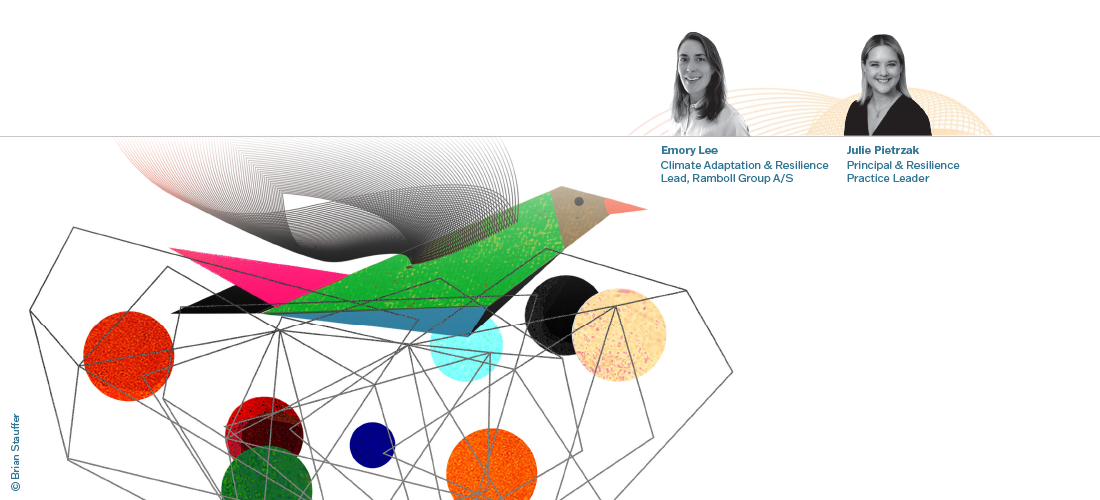Building Resilience For an Evolving World, And...
Resilience is a fundamental tool in our efforts to combat climate change. But how can it improve the present while helping protect our future?

Together with sustainability, decarbonization and corporate responsibility, resilience is a fundamental tool in our efforts to combat climate change. But how can it improve the present while helping protect our future?
We invited guest commentator Emory Lee, climate adaptation and resilience lead at Ramboll, to talk with Julie Pietrzak, the leader of our resilience practice, about the role resilience plays in our communities and the wider world.
HOW DO RESILIENCE AND SUSTAINABILITY DIFFER?
EMORY I understand sustainability to be how we safely support human existence while maintaining balance with the natural world. Another way to think about it is, how do we operate in a way that reduces the likelihood of future environment-related challenges? Resilience is the capacity to recover from difficulties – from foreseen or unexpected events. Challenges are inevitable, so how do we plan to best withstand future stressors?
JULIE Sustainability also looks for ways to reduce greenhouse-gas emissions. But even if we had already reached global net-zero emissions, more decades of warming are inevitable. Sea-level rise is inevitable. Resilience is essential for adapting to that future. Sustainability and resilience strategies often overlap. If a building can withstand an extreme weather event without requiring substantial repairs or replacement, it’s resilient and sustainable.
WHAT ARE THE BIGGEST BENEFITS OF RESILIENCE PLANNING AND DESIGN?
JULIE Climate change is one of the biggest global challenges we face, and resilient design strategies work toward adapting to future uncertainties. It’s a big ask, but it’s a process we’re up to taking on – one that involves constant iterations of learning and improving how we choose to plan and respond, while also balancing the triple bottom line.
EMORY The environment, social challenges and economic concerns: these systems all require resilience. If you look at them individually and holistically, that’s where we can have the biggest impacts – where we’re soliciting stakeholder input to understand how to meet the real needs of a community and get to equitable, deep resilience.
If a building can withstand an extreme weather event without requiring substantial repairs or replacement, it’s resilient and sustainable.
HOW DOES RESILIENCE FIT INTO THE BIGGER PICTURE OF DECARBONIZATION?
EMORY It’s all part of the same equation. I work primarily on resilience and adaptation projects, but I’m increasingly doing decarbonization work. They’re two sides of the climate-change coin!
JULIE We’ve seen the devastation caused by our carbon-centric economy, so we know we need to change that. But along with any change, we must also recognize that we’ve gone too far down this road to completely turn back the clock. We need resilience to increase our adaptive capacity, knowing we’ll continue to face acute events like extreme weather and chronic stresses like aging infrastructure.
WHAT TRENDS IN RESILIENCE WOULD YOU LIKE TO SEE CONTINUE OR EXPAND?
EMORY Economies are often resistant to change. To quicken the pace, some municipalities have started legislating resilience and decarbonization, and I hope to see that continue. Biophilic design – looking to nature for design insights – is the optimal approach for retooling our societies to be more sustainable and resilient. I’d like to see more design influenced by nature, and a move toward flexible multifunctional infrastructure as the norm – like Amager Hill in Copenhagen, a waste-to-energy plant that also provides accessible community recreational spaces.
JULIE I’d like to see mindsets continue to shift toward environmental justice – how resilience can benefit all communities, not just prosperous ones. This concept can be integrated into every project scale. For instance, if you’re designing for district-scale resilience, identifying strategies that benefit the wider community’s emergency preparedness and response, or at a building scale, incorporating input from operations and maintenance personnel. Ultimately, it’s about building a culture of resilience that will empower the end user long after we’ve completed the project.
